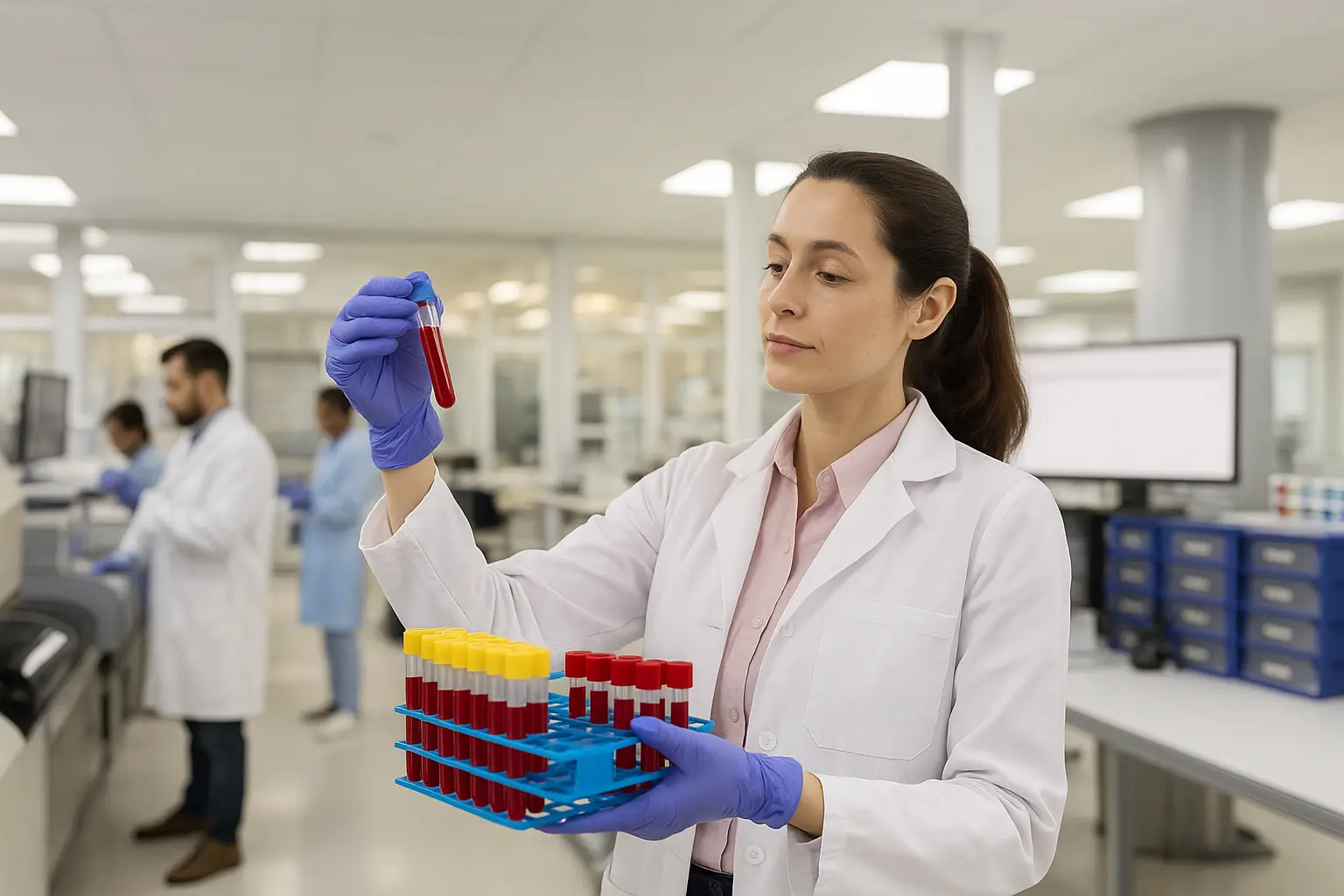Blog
Best Pathology Lab Reporting Software - Buyers Guide and Checklist
July 14, 2025
The healthcare industry continues to go through rapid changes. Demands and opportunities facing the modern laboratory are no exception. While the last few years have been dominated by changes (like the COVID-19 pandemic) that led to dramatic increases in demand, the trend of unprecedentedly high volumes is expected to accelerate thanks to recent advances in diagnostic lab software testing and personalized medicine.
This leads to a natural question: Are pathology labs prepared for this, and do they have the proper laboratory workflow management system and pathology reporting software in place to manage the job?
In an increasingly competitive (and regulated) marketplace, digitization and automation of clinical lab workflow are no longer “nice to haves” but rapidly becoming pathology lab software base-level requirements. Pathology labs that are slow to upgrade from legacy laboratory information systems (LIS software) risk losing clients and market share.
Discover More: Comparing LigoLab Informatics Platform with Legacy Laboratory Information System Software

Must-Have Medical LIS Software Features
No two laboratories are exactly alike, but one element is certain. To achieve maximum efficiency and better patient care, it’s imperative that bottlenecks and barriers are removed and patient safety is prioritized. That’s why partnering with laboratory information system vendors that offer all the modern medical LIS software features listed below is so important.
On-Demand Webinar: Learn How Modern Anatomic Pathology LIS Software Can Transform Your Lab’s Operations
Overview: Pathology Lab Software and Laboratory Workflow Management
While the work of a pathology laboratory is very different from that of a computer company or a delivery service, it’s useful to note that many key success factors are common across various industries.
For example, extremely successful companies such as Apple, FedEx, and Toyota, although representing very different industries, rely on streamlined manufacturing processes, intense focus on supply chains and logistics, rigorous quality assurance protocols, and internal state-of-the-art software systems that automate, integrate, and support these functions.
The pathology lab’s success factor is no different. The equivalent functions in pathology lab management by medical LIS software systems include workflow efficiency, seamless integration across all modules, automation of complex lab workflow processes, robust interoperability with various analyzers and electronic health record systems, and a growth-driven pricing model.
In terms of specific features that pathologists need this year and beyond, lab directors, managers, and owners should be looking for - among others - modern sample tracking systems, quality assurance protocols, integrated and customizable reporting and distribution modules, and laboratory software systems that support laboratory billing (lab revenue cycle management, lab RCM), direct-to-consumer lab testing (learn more about TestDirectly and TestDirectly.com here), voice recognition (pathology dictation software), and digital pathology workflow.
Industry Insights: Digital Pathology Redefined - Uniting AI, Viewers, and a Robust LIS System for a Seamless Workflow
Next, we’ll review the six best pathology management software features below before concluding with an outlook on the future of pathology lab software in general and offering those interested in a pathology lab report software demo the opportunity to learn more.
Request Demo: Speak with a LigoLab Product Specialist!

Key Pathology Lab Software Feature #1: Lab Sample Management System
Barcoding specimens—especially with Quick Response (QR) codes—is a fundamental function of any modern medical laboratory information system (LIS healthcare solution). For lab managers, the ability to integrate QR codes into electronic workflows should be a baseline expectation when evaluating laboratory information system companies.
Advanced LIS software portals for providers and patients, such as LigoLab Web Connect and TestDirectly, support QR-coded workflows that streamline processes by automating manual tasks and eliminating paper-based records. This digital infrastructure significantly reduces errors and enhances efficiency, enabling today’s laboratories to:
- Require less labor to track and report on specimens, which decreases costs and turnaround times, and increases throughput.
- Produce fewer errors, which are, at best, time-consuming to resolve and fix, and at worst, impact the lab’s reputation.
- Enable end-to-end automation by integrating sample tracking with a comprehensive lab sample management system that includes patient self-registration. This streamlines billing and reimbursement processes, boosts revenue and operational efficiency, and lowers labor costs.
Discover More: How Specimen Tracking Software Improves Efficiency and Reduces the Chance of Diagnostic Errors

Key Pathology Lab Software Feature #2: Medical LIS Software Reporting
Although lab result reporting to stakeholders—such as patients, physicians, and regulatory agencies—typically occurs at the end of the testing process, it’s often one of the first topics raised during discussions with LIS software vendors. That’s because timely, accurate, automated, and customizable reporting is critical to laboratory performance. Without modern pathology lab software supporting an advanced LIS system, reporting can quickly become a major source of inefficiency.
Industry experts agree that effective medical LIS software must include six core features for labs to remain competitive and operate at peak efficiency:
Medical LIS Software Characteristic #1: Interoperability
Effective medical LIS software must have connectivity with a wide range of electronic health records and laboratory revenue cycle management/lab billing services used by hospitals and health systems across the country. As such, the LIS system should be built with an open architecture, use a versatile interface engine, and support various formats and reporting requirements, including embedded PDFs, XML, and links in HL7 messages.
Medical LIS Software Characteristic #2: Flexibility
The best laboratory information system software should offer fully customizable report templates, including the possibility of client-co-branded or white-labeled reports. Similarly, modern laboratory information systems with embedded pathology lab reporting software solutions should offer features such as personalization, saved preferences, full-color rich text, diagrams, and images. These should be included with licenses and pre-loaded into the LIS system rather than treated as extra add-ons.
Medical LIS Software Characteristic #3: Configurability
Configurable reporting is a critical yet often overlooked feature of well-designed medical LIS software. When built directly into the LIS system platform, a flexible report template engine can significantly save time and resources. For optimal performance, it should support macros, attachments (such as images and diagrams), and annotations to enhance the clarity and value of each report.
Discover More: How LigoLab's Pathology Lab Software Supports Lab Report Customization and Client Preferences
Medical LIS Software Characteristic #4: Integration
A robust laboratory information system with modern pathology reporting capabilities should support synoptic reporting and seamlessly consolidate results from multiple departments into a single, clear, and comprehensive lab report.
Medical LIS Software Characteristic #5: Decision Support Systems
As healthcare shifts toward value-based care, leading laboratory information systems and workflow management solutions enhance lab reports with built-in risk assessment tools, such as clinical decision support and best practice protocols. This transforms reports from simple data outputs into actionable tools that support more informed and efficient clinical decision-making.
Medical LIS Software Characteristic #6: Automated Multi-Channel Distribution
Quality medical LIS software reporting should support the automated distribution of lab reports via multiple channels, including email, fax, provider and patient web portals, remote and local printers, and/or SMS/text messages.

Key Pathology Lab Software Feature #3: Scalable Pricing Model
If healthcare leaders learned anything from the COVID-19 pandemic, it’s that demand for pathology lab services can change extremely quickly.
While the immediate crisis of the COVID-19 pandemic has passed, many experts agree that future public health challenges are not only possible—they're likely. These unpredictable events will continue to disrupt the healthcare landscape, placing anatomical and clinical pathology labs on the front lines of response.
In this evolving environment, labs need to partner with laboratory information system vendors that offer flexible, scalable pricing. A rigid, one-size-fits-all pricing model can be inefficient, wasteful, and ultimately counterproductive, limiting a lab’s ability to respond quickly and adapt effectively.
The LigoLab Medical LIS & Lab RCM Informatics Platform addresses this with a uniquely designed tiered pricing structure for long-term alignment. Unlike traditional models that require significant upfront investments and impose licensing restrictions, LigoLab’s approach eliminates these barriers. It includes unlimited user seats, comprehensive support, and ongoing LIS system maintenance, all of which empower labs to focus on growth, innovation, and operational excellence.
Discover More: LigoLab Informatics Platform: Uniquely Designed to Deliver Maximum Value
Key Pathology Lab Software Feature #4: Laboratory Billing/Lab RCM
Claims processing is one of the most labor-intensive aspects of laboratory billing, often slowing down operations and increasing costs. To address this, the best LIS software platforms now include fully integrated lab billing functionality as part of a complete LIS lab informatics solution.
The gold standard in today’s laboratory information systems is “no-touch” billing—automated workflows that verify patient demographics and insurance eligibility at the time of registration. This real-time data validation accelerates the RCM process for both payers and clients, streamlines operations, and boosts cash flow.
Automating the laboratory billing process enables testing organizations to minimize errors, reduce administrative expenses, speed up reimbursements, and allocate working capital more efficiently.
Discover More: Why Integrated LIS System and Lab RCM Software is a Catalyst for Growth
While lab billing automation can be challenging for any organization, successful pathology lab reimbursement depends on robust lab RCM software that adapts to evolving regulations and ensures ongoing compliance.
Key Pathology Lab Software Feature #5: Pooled Testing Capability
One interesting innovation for pathology labs is pooled testing, which involves processing multiple specimens together in a single batch. When done effectively, pooled testing enables pathology laboratories to increase capacity, decrease turnaround time, and reduce cost.
The best LIS systems support pooled testing and can track multiple specimens simultaneously after barcoding them, which is complex and error-prone if attempted manually. Another crucial part of pooled testing is the ability to track the retesting of positive samples for confirmation. Modern LIS lab software must support this.
Key Pathology Lab Software Feature #6: Digital Pathology
Digital pathology and its integration with anatomic pathology LIS systems became increasingly important during the rise of COVID-19, with pathologists, thanks to relaxed guidelines, choosing to swap their glass slides for digital ones and the laboratory setting for a home office digital pathology suite.
With the regulatory hurdle gone, more pathologists are embracing modern digital pathology solutions to improve efficiency and image management, and rapid growth is expected to continue.
Modern laboratory managers and owners are leveraging advanced LIS software like the LigoLab platform and its proprietary interface engine to capitalize on this growth and ultimately serve patients better. The LigoLab platform seamlessly integrates with whole-slide imaging scanners that digitize glass slides into digital slides.
Discover More: LigoLab Delivers the LIS System Interoperability Needed to Transform Medical Laboratories into Thriving Businesses
It’s believed that digital pathology, aided by deep learning methods and image analysis powered by artificial intelligence, will continue to advance within the pathologist community as diagnostic confidence in this sub-field of pathology grows.
Discover More: How AI Can Propel Medical Laboratories into a New Era of Growth

Book a Pathology Lab Software Demo Today to See These Features in Action
As outlined above, modern high-volume pathology labs need laboratory information system software that is both powerful and adaptable. Essential features include advanced sample tracking, customizable reporting, flexible pricing, integrated lab billing, support for pooled testing, seamless interfacing, and more.
LIS software solutions that lack this level of functionality can hinder a lab’s ability to optimize workflows and scale effectively.
Fortunately, the LigoLab platform delivers all the tools and capabilities today’s pathology labs need to thrive.
To experience the advanced informatics platform for yourself, book a demo here.
The Future of Pathology Lab Software
As in many industries, the pathology lab software market has been divided into leaders and laggards, largely based on how effectively companies leverage technology within their business models.
The COVID-19 pandemic accelerated this shift, firmly establishing advanced laboratory information systems as the new baseline standard for pathology labs.
Lab directors, managers, and owners who delay these critical investments risk falling behind. Those who embrace modern medical LIS software technology are well-positioned to gain a competitive edge and drive long-term success.
Discover More: Can Your Laboratory Information System Support the Latest LIS System Technology?







